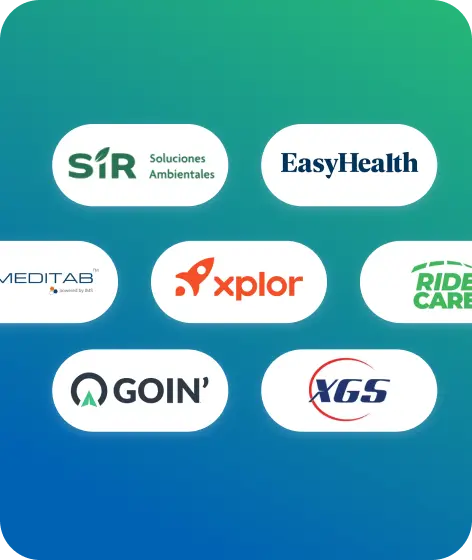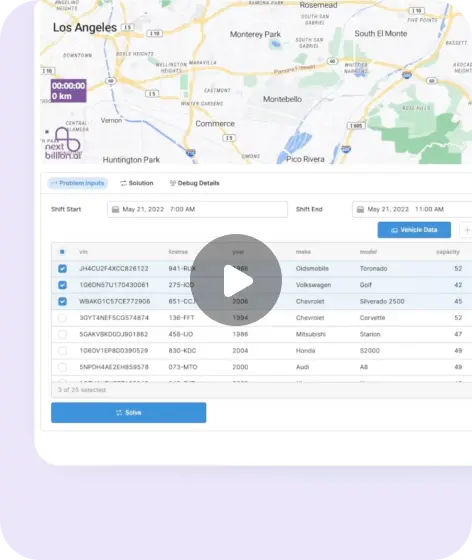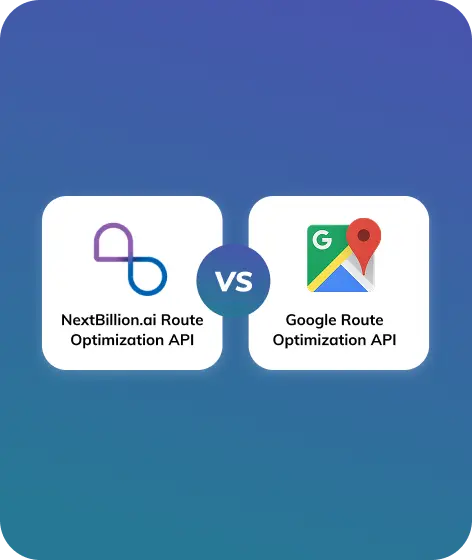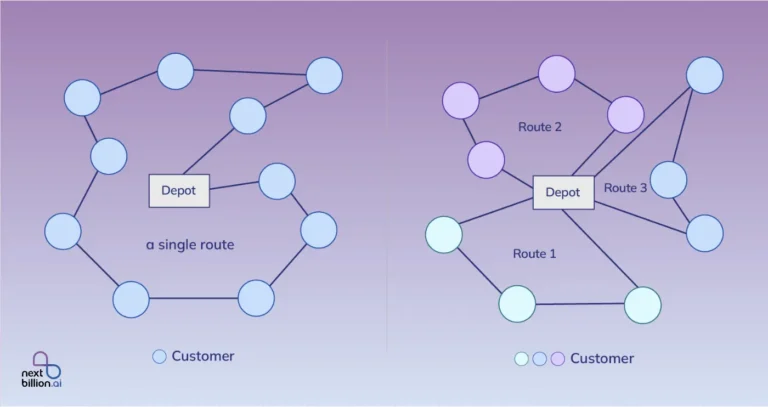
Table of Contents
GPS-Enabled routing trackers are now essential for any field service business due to growing customer expectations for same-day or even same-hour delivery. With inflation rates rising, it is also essential to take advantage of every opportunity to reduce operational costs.
Fuel costs and maintenance and repair are two expenses in fleet management that can drastically increase operational costs. Fuel costs rise due to poor routing, and ultimately, excessive vehicle use without timely maintenance leads to an increase in repair costs.
However, planning routes for multiple stops is challenging, and using pen and paper or a free route planner does not guarantee geospatial accuracy or real-time efficiency. As a result, several field service businesses started using complex GPS navigation trackers with dynamic route optimization features that provide optimized routes for many sites with turn-by-turn directions along with fuel cost savings of up to 20%.
GPS-enabled routing systems use satellite data to identify the most efficient path from a starting point to one or more destinations. Such route planners effortlessly handle constraints like real-time weather updates, traffic congestion data from integrated sensors, and one-way street mapping through geofencing. The ideal strategy is to automate GPS route trackers and find the quickest routes in less than 30 seconds using high-speed processing.
Key Challenges in Fleet Cost Management
Efficiency in the fleet management system is critical to profitability. Every delivery, every mile driven, and every fuel fill-up affects your business’s cash flow. If you don’t manage your fleet correctly, expenses can easily slip through the cracks.
Managing fleet expenses is difficult, with multiple factors contributing to rising costs. One of the most significant challenges is fuel consumption, which is monitored via onboard diagnostics (OBD-II) and telematics. Fuel consumption varies depending on vehicle usage, driving habits, and route inefficiencies.
In addition to fuel management, predictive vehicle maintenance based on IoT sensors is a critical consideration, especially when vehicles are not regularly monitored for wear and tear. Unscheduled maintenance can lead to extended downtime, reduced productivity, and higher repair costs.
Inefficient routing is another challenge that many companies face. Sending vehicles on longer, less economical routes without proper tools, such as AI-driven smart route planning, places unnecessary strain on vehicles and increases fuel consumption. Additionally, poor driving habits such as excessive idling detected via GPS-based engine diagnostics or forceful braking monitored via accelerometers can further reduce fuel efficiency and drive up maintenance costs over time.
Route optimization with GPS tracking is the key to getting a complete view of your fleet operations and improving your workflow efficiency.
What is GPS Fleet Tracking?

GPS fleet tracking solutions utilize real-time satellite positioning, enabling businesses to design and optimize delivery routes. This comprises determining the most efficient or optimum route for drivers, taking into account a variety of criteria such as real-time traffic data feeds, route distance optimization, and delivery time windows.
This technique is automated using advanced logistics software integrated with GPS and telematics, allowing fleets to operate more efficiently while saving time and resources. For instance, NextBillion.ai’s Map Fusion is an integrated platform that combines mapping and routing, making it easier for managers to decide the routes and drivers to navigate safely and optimally in any area.
Benefits of GPS-Enabled Routing for Fleet Management
GPS systems offer numerous advantages, including monitoring vehicle positions and improving navigation, optimizing routes, and increasing fleet security. They also help decrease costs and streamline operations, reduce shipping costs, increase productivity, assure timely delivery, promote safer driving practices, and lower the risk of theft.
Here, we’ll look at the primary benefits of implementing GPS technology into a fleet management system.
1. Improved Route Optimization to Reduce Fuel Consumption

One of the most significant benefits of GPS-enable route optimization software is reduced fuel costs. This technology reduces the distance that trucks have to travel by calculating the most efficient routes using real-time GPS data and advanced route optimization algorithms.
Businesses that rely heavily on delivery services may see significant fuel cost savings. For example, a 10% reduction in the distance driven, calculated through automated GPS-based route planning, can result in significant fuel savings.
2. Time Savings Leading to Fewer Overtime Expenses

Another advantage is that route optimization software can help you save on labor costs. Using the most efficient routes helps companies reduce the number of drivers needed to do the work by shortening the time required to complete each route through real-time route recalculation and automated dispatch integration.
This can help delivery businesses save labor expenses and manage resources more efficiently. For example, if your drivers can complete their routes more quickly due to dynamic GPS-driven adjustments, you may not need to hire additional drivers to satisfy demand.
3. Decreased Maintenance Costs by Optimizing Vehicle Usage
Route optimization software may help reduce the cost of vehicle maintenance while saving money on fuel and labor. Businesses can reduce the pressure on their vehicles, leading to lower maintenance costs, by shortening the length and duration of each route through GPS-based vehicle diagnostics and predictive maintenance scheduling.
By integrating a GPS-enabled routing system with a telematics system, the fleet can work at peak efficiency. Telematics collects data from the vehicle sensor, and using that data, the route optimization software will exclude a particular vehicle that looks unfit for longer routes.
4. Environmental Impact for Sustainability

Efficient route planning also contributes enormously to lowering environmental impact. Fleet vehicle emissions are greatly reduced by planning routes to limit distance driven and idle time, utilizing real-time traffic data and emission tracking systems.
This reduction in fuel use not only saves money but also helps reduce the fleet’s environmental impact. Businesses that show a dedication to sustainability in an eco-conscious market not only stick to environmental standards but also win over a growing number of environmentally aware consumers.
How Can GPS Tracking Streamline Operations?
Let’s understand how GPS-enabled routing can streamline fleet operations:
1. Real-Time Data for Route Adjustments
Real-time route tracking allows businesses to see the whereabouts of their delivery vehicles in real time. This information enables fleet managers to make quick judgments and respond to unknown challenges, such as traffic congestion and road closures, using GPS-based live traffic feeds and automated rerouting algorithms. By dynamically rerouting vehicles, businesses can reduce driver idle time and ensure timely product delivery.
GPS tracking systems also allow fleet management to track driver behavior and target areas for improvement. Businesses may reduce fuel consumption, vehicle damage, and insurance costs by encouraging sensible driving habits, such as eliminating excessive speeding or hard braking using telematics-based driver performance analysis. GPS tracking improves delivery efficiency by optimizing driver performance.
2. Improved Dispatching Processes
Optimizing delivery routes requires efficient dispatching. Businesses can use GPS tracking systems integrated with automated dispatch software to automate their dispatch processes, making them faster and more precise.
Dispatchers may track real-time vehicle position and status using geolocation data and fleet management dashboards, allowing them to assign drivers based on proximity and availability. This reduces unnecessary travel and guarantees that the most appropriate driver is assigned to each delivery.
Dispatchers can successfully use GPS tracking to manage last-minute modifications and urgent orders. They can swiftly reroute cars, change schedules, and send updated information to drivers using real-time communication tools and GPS-based notifications. As a result, GPS tracking increases agility and responsiveness, allowing businesses to address customer demands quickly.
3. Enhancing Vehicle and Cargo Security
Businesses that handle delivery operations must ensure the safety and security of their trucks and cargo. GPS tracking systems with geofencing capabilities and real-time alerts provide continuous monitoring. It allows fleet managers to detect any unlawful vehicle use and deviation from planned routes.
GPS tracking devices offer real-time location information in the case of theft or unauthorized entry into a vehicle. It facilitates quicker response times and improves recovery prospects. These security measures eventually reduce risks, safeguard precious assets, and protect enterprises from potential losses.
4. Optimized Routing through Analytical Insights
In addition to real-time monitoring and dispatching benefits, GPS tracking technology provides various analytical insights through advanced data analytics platforms. Businesses can improve their routes over time by examining historical data collected via GPS logs to determine traffic patterns, preferred routes, and typical delivery times.
Companies can use GPS route optimization software powered by advanced algorithms to build efficient routes automatically. By taking into account variables like distance, real-time traffic congestion data, and delivery windows, businesses can design routes that optimize delivery efficiency and save travel time. This level of route optimization not only lowers expenses but also increases delivery reliability.
How to Make the Best of GPS-Enable Routing: Integration with Other Technologies
Telematics systems integrated with GPS tracking take data from vehicles and convert it into useful insights for making better decisions. Vehicle telematics has grown over time, adding cellular modems, GPS modules, accelerometers, backup batteries, and sensor connections, resulting in a more computerized telematics system.
This device improves vehicle safety and assists with GPS navigation, roadside assistance, traffic avoidance systems, automatic emergency services dialing, and optimized EV charging schedules.
The GPS fleet tracking and management system is a vital component of vehicle telematics. It ensures constant fleet tracking and enables scalability through cloud-based data storage and real-time analytics dashboards for organizations of all sizes.
Besides, integrating Artificial Intelligence (AI) into vehicle tracking systems improves efficiency by assessing traffic conditions via real-time sensor networks, road closures from live data feeds, weather conditions, and user preferences.
AI algorithms generate the most efficient routes using machine learning models trained on historical traffic data and real-time inputs. For example, NextBillion.ai employs AI algorithms which consider more than 50 parameters, like live traffic data, expected delays, and alternate routes, to recommend the shortest and the most efficient routes.
Machine learning algorithms can forecast where and when congestion will occur, allowing the system to suggest alternate routes. For example, AI in navigation systems such as Google Maps forecasts rush-hour traffic patterns and recommends departure times to avoid high-traffic periods.
AI is a critical component of Advanced Driver Assistance Systems (ADAS), which include features such as automatic emergency braking (AEB), lane-keeping assistance, and adaptive cruise control. These systems use AI to evaluate data from onboard cameras, LIDAR sensors, and radar systems, allowing the vehicle to react to its surroundings and avoid collisions.
Reduce Fleet Management Costs with NextBillion.ai

NextBillion.ai presents a highly customized platform, MapFusion, for complex fleet routing and mapping challenges, reducing significant costs. This system allows businesses to successfully optimize and track fleet operations while accommodating specific business requirements through customizable APIs and SDKs.
1. Optimize Multi-Vehicle Route
NextBillion.ai’s Route Optimization API offers users a high level of customization by exploiting various parameters that closely simulate real-world route planning constraints. Users can apply vehicle-specific attributes like vehicle capacity, load type, and delivery time windows to solve optimization challenges for multiple vehicles in a fleet.
2. Enter and Exit Geofencing Alerts
The NextBillion.ai Live Tracking API enables users to track their fleet vehicles in real time and receive automated alerts based on geofence boundaries. Users can utilize the Geofence API to create specific geographical boundaries, which can be integrated with the Live Tracking service to receive notifications when vehicles enter or exit predefined zones.
3. Turn-by-Turn Navigation Instructions
The Navigation API from NextBillion.ai provides step-by-step directions in the selected language, ensuring drivers have a seamless navigation experience.
4. Avoid Sharp Turns and U-Turns
The platform includes an avoid parameter to customize routes. With this, fleet managers can ensure compliance with safety regulations and route constraints by avoiding highways, toll roads, service roads, and unsafe turns based on the fleet’s specific requirements.
5. Routing for Hazardous Material
The system can account for the type of material being transported by setting the “hazmat_type” parameter. The routing engine ensures vehicles carrying hazardous materials are directed along safe and legally approved routes.
6. Speed Violation Alerts
The Live Tracking API offers real-time speed monitoring and sends alerts when vehicles exceed specified speed limits. This feature helps enforce safe driving practices and compliance with speed regulations while reducing the risk of accidents and penalties.
7. Trace the Route Taken
With the Post Trip Route API, businesses can track the exact route taken by vehicles, providing data on the distance covered and route geometry. This information supports functions like fuel allowance disbursement, mileage documentation, and service quality assessments.
8. Live Tracking and ETAs
Track vehicles with an accuracy of up to one meter and get reliable live ETAs through the Distance Matrix API. This feature leverages both real-time traffic patterns and historical data and handles one-to-many and many-to-many routing scenarios, offering highly accurate delivery timelines.
Conclusion
In the competitive logistics world, meeting consumer expectations while minimizing costs is a difficult issue. However, GPS-enabled route tracking systems allow for a balance between these two key goals. They improve the customer experience and lower operating costs by providing real-time updates through live GPS feeds and advanced route optimization algorithms.
The transparency and efficiency provided by GPS-enabled last-mile delivery tracking technologies are game changers for businesses wanting to stay ahead of the delivery curve.
If you want to save time and money while also selecting the finest overall fleet routing option, NextBillion.ai’s MapFusion is an excellent choice. Its extensive set of routing limitations, sophisticated GPS route optimization algorithms, capacity to manage large-scale fleet operations through cloud-based infrastructure, and 24/7 proactive support teams ensure that your fleet’s routing requirements are met.
So, get a demo today to experience our solution in action and see how it can optimize your fleet operations, reduce costs, and improve overall efficiency.
FAQs
Implementing a GPS tracking system can help fleet managers find cost-saving options while increasing overall efficiency. GPS devices provide real-time route data, helping cars avoid traffic and inefficient paths. Similarly, GPS systems monitor vehicle activity, assisting fleet managers in identifying and reducing needless idle time, which has a direct influence on fuel consumption and engine wear.
Fuel expenses are an ongoing concern for fleet managers. They are difficult to manage because they have no control over fuel prices. GPS monitoring and fleet management software enable you to monitor fuel usage, driving behavior, and fuel theft to improve your fleet’s overall fuel consumption and reduce fuel expenditures.
Driver behavior monitoring and measurement is an important feature to search for. This allows you to analyze your drivers’ behavior, including forceful braking, speeding, acceleration, and excessive idling. You can share the insights with drivers to help them avoid accidents and reduce fuel expenditures. In addition, the software can calculate driver earnings and schedule trips.
About Author
Bhavisha Bhatia
Bhavisha Bhatia is a Computer Science graduate with a passion for writing technical blogs that make complex technical concepts engaging and easy to understand. She is intrigued by the technological developments shaping the course of the world and the beautiful nature around us.










